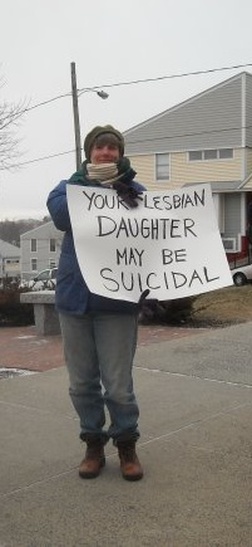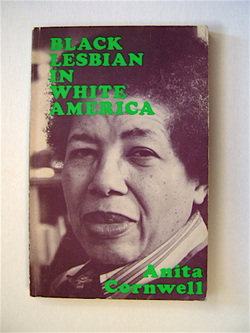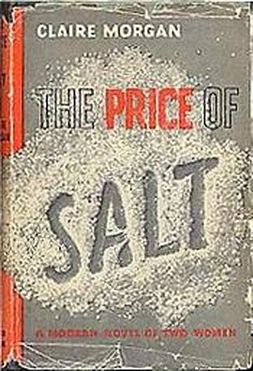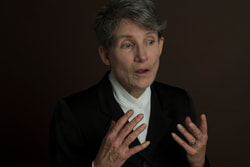 The Author Goes to Church
The Author Goes to Church “The end was contained in the beginning. But it was frightening; or, more exactly, it was like a foretaste of death, like being a little less alive.”
--George Orwell, 1984.
This is what I thought of when I read that 59% of Americans believe in hell. (That’s from a 2009 poll by The Pew Forum on Religion and Public Life. A Fox News poll puts the figure at 74%!)
It struck me that this is a serious political issue, as well as one of children’s rights, and one that needs to be understood in the light of Post Traumatic Stress Disorder, or PTSD.
What exactly does it mean that the majority of folks in my country actually believe that they face the possibility of being tossed into a lake of burning hellfire at the end of their lives, where they would experience the excruciating symptoms of being burned alive for eternity? What does it mean that the majority of folks in my country believe that the universe is governed by a tyrannical despot capable of devising this form of torture for beings that he has created and then tempted into damnation?
Honestly, I can’t even imagine taking these propositions seriously. I can’t even imagine going through a day with the possibility of an invisible judge breaking my arm at midnight for some potential trangression on my part I may have even inadvertently committed during the day. I can’t imagine waking up in the morning and looking out the window on a beautiful day, realizing that somewhere beyond the green hills and clouds lies a sulfurous penal colony filled with the screams of the damned—some of them my family and friends!—and knowing that there is a great creator who takes equal proprietary pride in this nightmare underworld. I can’t imagine wishing such a retaliatory, over-kill horror on even a known predator. How do any of these believers—these one-out-of-six of my fellow Americans—ever have a nice day?
 Imagine believing this... No, really.
Imagine believing this... No, really. Actually, I do know how they have a nice day. I know what it’s like to be completely dependent on a paternal co-creator and guardian who is grandiose, sadistic, and terrifying. I understand what it’s like to scramble to make sense out of a stream of incoherent, inconsistent edicts, because one’s survival requires an unquestioning faith in the madman who issued them. I live with the aftereffects of assuming a guilt that should never have been mine, as the only way to balance this unbalanced power equation. Fortunately, I was able to outgrow and outlive my perpetrator/human father. For fundamentalist believers in hell, there is no way out, and the post-traumatic adjustments that a child must make to accommodate the unthinkable must form a lifetime of disorders for fundamentalist believers, which then become codified into holy writ.
Belief in hell and its creator are profoundly traumatizing. They comprise an unacceptable ideology that must be accepted by the faithful. That, in a nutshell, is the definition of trauma: the unacceptable that must be accepted. And accepting the unacceptable is what causes Post-Traumatic Stress Disorder, PTSD. And, as George Orwell so presciently put it, living with this kind of trauma is like “being a little less alive.”
How, specifically, might PTSD play out among the faithful? Let’s take a look at some of the syndromes:

My first thought is “How useful for the patriarchy!” How easy to sell doctrinal hellfire survivors on terrorist alerts, and especially when those terrorists are characterized as infidels. And for what exactly would the person with hellfire PTSD be so vigilantly scanning the environment? What are the perceived sources of threats to life—or, rather, to afterlife? Soldiers with PTSD are hypervigilant about being ambushed. Women and children who have been vicitimized are scanning for perpetrators and assailants. But what about these folks believing in hell? They must be eternally vigilant for temptation, erring on the side of paranoia.
Which brings us to a related symptom of PTSD:

In an effort to minimize risk of retraumatization or reduce anxiety (see “hypervigilance” above), the survivor attempts to control her environment. She may restrict her activities, pass up opportunities that involve too many unknowns, avoid social contact. She will choose the unpleasant familiar over opportunities and changes that involve risk, however slight. Constriction refers to the narrowing of her experience that results from hypervigilent choices.
For anyone who sincerely believes in eternal damnation, avoiding this punishment must obviously be a top priority. There must be diligent, ongoing attention to the maintenance of a reassuring balance of goodness in one’s moral bank account. Constriction, in this instance, would be the result of avoiding any activity that might incur debt in that account, however unintentional. And here we have an explanation for religions that ban dancing or theatre, as well as a rationale for rigid gender roles and brutal child-raising practicies.
But constriction for the faithful goes beyond that. The greatest temptation to sin lies in freethinking. The constricted thought of the orthodox is well documented, and the political dimensions of this constriction are chilling. Voting along church party lines could be interpreted as a form of constriction. Black-and-white thinking with good-versus-evil moral codes may keep one out of hell in an afterlife, but they are set-ups for fascist propaganda that leads to the creation of hell on earth. Which, sadly, is still a preferable option, and possibly one that provides a measure of catharsis… which we’ll get to later.

Teaching people to believe in hell is diabolically ingenious. It can wire them for active PTSD for their adult lives. It impairs their capacity for logical thinking. And, of course, indoctrinating (traumatizing) children with this belief before they are able to think for themselves is ridiculously easy for adults, especially if they are the parents.
Let’s look at a third syndrome associated with PTSD:
3) Dissociation
Dissociation refers to “partial or complete disruption of the normal integration of a person’s conscious or psychological functioning.” This occurs when the mind is desperate to distance itself from an experience that is too much to process… like, say, the thought of being burned alive for eternity by one’s own creator.
Dissociation can take various forms. One can feel outside one’s own body or experience (depersonalization), or disconnected from one’s surroundings (derealization). One can become numb or forgetful. And here’s an arresting bit of information from a study on maternal PTSD: Adult dissociation when coupled with a history of child abuse and PTSD can contribute to disturbances in parenting behavior, such as exposure of young children to violent media. Could this explain how adults terrorized by their own indoctrination into eternal damnation feel justified in imposing it on their children? Is sending their kids to Sunday school actually a post-traumatic compulsion?
Let’s take a closer look at depersonalization and derealization.
Depersonalization, defined as the subjective experience of unreality in one’s sense of self, can be a relief. In fact, depersonalization is the desired outcome of many recreational drugs. In the face of a terrifyingly unjust cosmos, depersonalization could lead to abdication of personal responsibility for one’s fate… and all that would follow from that. What constitutes moral idiocy or criminal insanity in a universe manifesting premeditated cruelty and injustice?
In fact, the entire notion of sin stems from a kind of universal depersonalization. The notion of sinners does not take into account the effects of organic brain damage, the disease model of addiction, and a host of research into trauma and its effects, especially on children. People who sin are simply bad, deserving of lakes of fire.
Derealization, a state of dissociation in which the outside world is experienced as unreal, is even scarier. And here, I believe, we have the explanation for the Rapture. Some Christians actually advocate acceleration of the destruction of the environment, because, according to their ideology, the end of the world will bring all them that must closer to the Rapture, when the true believers will be united with their savior. Traumatic beliefs about hell can result in brutal indifference to beings and worlds that are seen as existing apart from ideologies of salvation. Gays, lesbians, and transgender offspring of evangelical families can testify to the stunning cruelty of this dynamic.
Here’s the fourth syndrome:

This is about helplessness. This is a survival instinct that kicks in when flight or fight are not options. In the freeze response, the body is flooded with the same neuroendocrines as during fight-or-flight; it’s just that there is not the discharge that occurs with fighting or fleeing. This can set the stage for something called “dysregulation,” where the energy mobilized by the perceived threat gets trapped in the nervous system by the freeze.
Dysregulation means the body holds onto stress and has trouble letting go, with the result that the trauma survivor feels both wired and exhausted at the same time. In lay terms, the body’s transmission has broken down. The person suffering from dysregulation has difficulty shifting from high arousal to low arousal, shifting back to neutral, or into states of joy or contentment. Chronic anxiety and depression are states of dysregulation, and dysregulation can result in religious obsessions… or traumatic re-enactment.

This compulsive seeking-out of situations that resemble the trauma is usually not conscious. It’s an attempt to gain closure, and may provide a temporary sense of mastery or even pleasure, but ultimately it perpetuates chronic feelings of helplessness and a subjective sense of being bad and out-of-control… which feed the compulsion to re-enact, setting up a vicious circle that, without intervention, is likely to end in tragedy.
How might this work when the PTSD derives from a traumatic ideological belief in an eternity of hellfire? Okay, this is pure speculation on my part, but might the re-enactment compulsion take the form of creating rigidly hierarchical, patriarchal structures that replicate imagined scenarios of Judgment Day? Or waging wars against infidels to project an overwhelming fear of sinfulness onto some “other” who can then be appropriately punished (exorcised)… and the more fiery the punishment the better? Are the infernal weapons of modern warfare some subconscious attempt to gain godlike control over the dreaded hellfire?
The fact is that belief in a literal hell, however ludicrous to us non-believers, constitutes a traumatizing belief. Spending one’s life attempting to appease a tyrannical and fickle creator/destroyer who insists on being worshipped as a loving father is also profoundly traumatic, and especially if it dovetails with one’s experience of an abusive parent. PTSD, as we know, compounds.
What does it take to confront and heal PTSD? Usually some kind of intervention, because of the way the amygdala operates. The person with PTSD has a brain that is insisting on external causes (temptation, sin, etc.). Out of touch with the logic and reason of the cortex, this part of the brain lacks the capacity to examine its own process. Just as alcoholism is referred to as “the disease that insists it’s not a disease,” PTSD is the syndrome that insists it’s not a syndrome.
Unfortunately, these hellfire believers are highly organized and their churches are deeply involved in the funding of political parties… which means influencing or even dictating the party platforms. They are well beyond appeals to logic.
Is there any form of intervention at this point that might be effective against this army of believers hell-bent to not be hell-bent?
I think there is, and I think the key is children’s rights. Children have a right to grow up free to develop their own relationship to the world and to the energies of creation. They have a right to grow up free from religious doctrines teaching intolerance and terror. Research shows that fundamentalist teachings about same-sex orientation lead LGBT youth to suicidal ideation and self-harm.
Unfortunately children do not have political clout. They will never have their own party, or even their own PAC. They are the most universally exploited population on the planet. There was a national database for stolen cars years before there was one for abducted children. Certainly, an initiative defending their rights to spiritual self-determination would be daunting. Daunting, but effective. As lesbian-feminists, we can begin in our own communities, wherever churches are in coalition with other organizations. We can begin by including it in our own analyses, making it part of any human rights platform. We can make sure that it’s articulated when we work on anti-bullying campaigns. We can educate people that religious freedom does not include the right to spiritually abuse.
And in doing this work, we can also take the opportunity to look at our own beliefs about an afterlife. Is our end also contained in our beginning? Personally, I find purpose, peace and morality in an observation made by feminist sociologist and novelist Charlotte Perkins Gilman:
“Eternity is not something that begins after you are dead. It is going on all the time.”









 RSS Feed
RSS Feed
